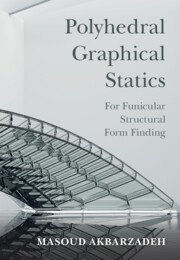Book contents
- Frontmatter
- Dedication
- Contents
- Contributors
- Foreword
- Foreword
- Preface
- Acknowledgments
- Introduction: A Brief History
- 1 Equilibrium of a Single Node
- 2 Equilibrium of a System of Forces
- 3 Compression-Only Form Finding
- 4 Articulated Compression-Only Forms
- 5 Systems with Combined Tension and Compression
- 6 Geometric Degrees of Freedom in Design of Form and Force Diagrams
- 7 Algebraic Formulation for Polyhedral Graphic Statics
- 8 Broader Applications of Polyhedral Graphic Statics
- References
- Index
5 - Systems with Combined Tension and Compression
Published online by Cambridge University Press: 13 March 2025
- Frontmatter
- Dedication
- Contents
- Contributors
- Foreword
- Foreword
- Preface
- Acknowledgments
- Introduction: A Brief History
- 1 Equilibrium of a Single Node
- 2 Equilibrium of a System of Forces
- 3 Compression-Only Form Finding
- 4 Articulated Compression-Only Forms
- 5 Systems with Combined Tension and Compression
- 6 Geometric Degrees of Freedom in Design of Form and Force Diagrams
- 7 Algebraic Formulation for Polyhedral Graphic Statics
- 8 Broader Applications of Polyhedral Graphic Statics
- References
- Index
Summary
In this chapter, we started with a graphical analysis of a simple truss system to explain the properties of force diagrams and the geometry of the equilibrium of systems with both tensile and compressive members. We showed the procedures to analyze polyhedral truss systems and explained the conditions of overhangs and their effect on the force diagram. We continued by visiting systems with self-intersecting nodal force polygons in both 2D and 3D.
We also showed examples of structures with static degrees of indeterminacy and their reciprocal force diagram. The geometric degrees of freedom in the force diagram of a polyhedral truss show a minimum number of states of self-stress in a system. We then introduced design techniques such as subdividing the applied load network and the cut and extrude method that can manipulate and carve the force diagram of a simple truss and derive articulated funicular systems with combined tensile and compressive members in 2D and 3D.
We also introduced the topic of force optimization by containing the force diagram to particular geometries. Finally, we showed an approach to realizing a funicular network for real-world application by embedding the thrust in anticlastic periodic surfaces using Volumetric Modeling and Signed Distance Functions to enhance the performance of such systems under asymmetric loading.
Keywords
- Type
- Chapter
- Information
- Polyhedral Graphical StaticsFor Funicular Structural Form Finding, pp. 234 - 303Publisher: Cambridge University PressPrint publication year: 2025

